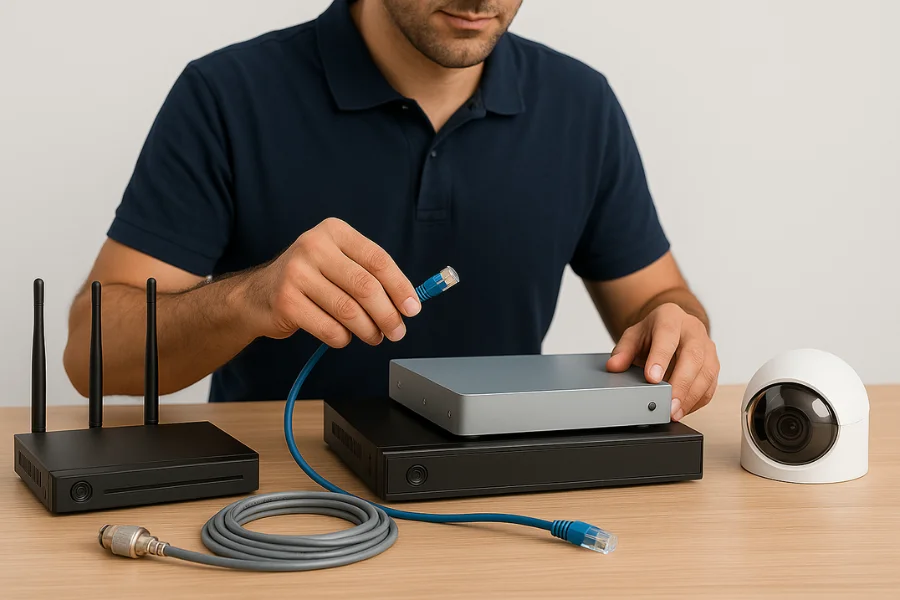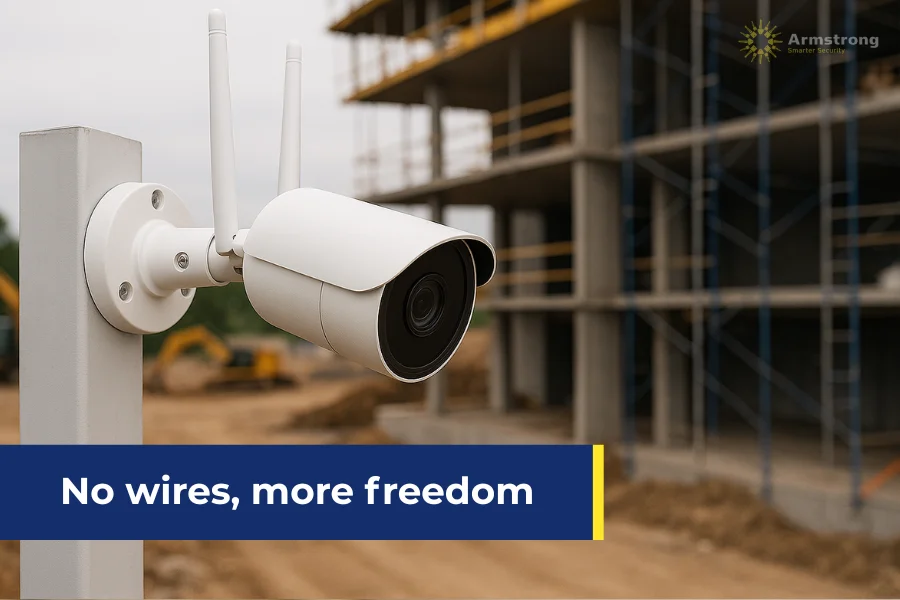
Video Transmission and Storage Solutions for CCTV Systems: Wired, Wireless, Recorders, and Compression Explained
The effectiveness of any CCTV system depends not only on the cameras but also on how video is transmitted and stored. Transmission and storage play a central role in determining the system’s performance, reliability, and scalability.
Poor transmission can lead to signal loss or image degradation, while inadequate storage may result in gaps in footage or poor-quality playback.
For commercial environments, where consistent video quality and long-term storage are often required, understanding these technical aspects is critical.
Choosing the right transmission method affects how far video signals can travel without interference or delay. Similarly, selecting the right type of recording system and data compression format ensures that footage is stored efficiently without compromising visual clarity.
Whether you are planning a small surveillance setup or a large multi-site deployment, having a clear grasp of wired versus wireless transmission options, the role of DVRs and NVRs, and how compression formats impact storage will help you make informed decisions.
This guide will walk through each of these core elements, providing a practical overview of what to consider and how each choice affects overall system performance.
Wired Transmission Methods

Wired transmission is the backbone of most reliable CCTV systems. It offers stable signal delivery, consistent image quality, and minimal interference, making it the preferred choice for many commercial installations.
The type of cable used directly influences video clarity, distance coverage, and system scalability. Understanding the differences between coaxial, twisted pair, and fibre optic cabling helps ensure your CCTV system performs as expected in its operating environment.
Coaxial Cables
Coaxial cable has long been used in analogue CCTV systems and remains in service today, especially in legacy installations or budget-conscious projects. It consists of a central conductor, insulation, a metallic shield, and an outer jacket.
Advantages:
- Simple to install and widely available
- Compatible with DVR-based systems
- Supports HD analogue formats like HD-TVI, HD-CVI, and AHD
Limitations:
- Distance limitations without signal boosters (typically up to 300 metres)
- Limited bandwidth compared to digital systems
- Not suitable for Power over Ethernet (PoE)
Coaxial cable may still be practical for smaller sites or when upgrading an existing analogue system without a full overhaul.
Twisted Pair (Cat5e/Cat6)
Twisted pair cables, especially Cat5e and Cat6, are standard in modern IP CCTV systems. They are commonly used in networking and support, both data and power transmission, when paired with PoE.
Advantages:
- Supports PoE, reducing the need for separate power lines
- Capable of carrying both video and data
- Scalable for larger systems with multiple cameras
- Supports longer distances with signal boosters or switches (typically up to 100 metres per run)
Limitations:
- Susceptible to electrical interference if not properly shielded
- Requires compatible network switches and routers
Twisted pair cabling offers a strong balance of flexibility, cost-efficiency, and performance, especially in buildings with existing Ethernet infrastructure.
Wireless Transmission

Wireless CCTV transmission offers an alternative to traditional cabling, particularly useful in areas where installing physical wiring is difficult, expensive, or disruptive.
While not as universally reliable as wired systems, wireless technology has advanced significantly, making it a viable solution for many surveillance applications.
The choice to go wireless depends on the specific layout of the site, the need for flexibility, and the intended use of the cameras.
RF and Microwave Transmission
Wireless CCTV systems typically rely on radio frequency (RF) or microwave signals to transmit video from the camera to the receiver. These methods can eliminate the need for cables and support rapid deployment.
Applications:
- Temporary surveillance setups (e.g., construction sites, events)
- Remote areas where running cables is not practical
- Mobile units such as patrol vehicles or field monitoring stations
Advantages:
- Quick to install and reconfigure
- Reduces installation disruption in existing buildings
- Provides flexibility in camera placement
Limitations:
- Line-of-sight is often required for a stable signal.
- Bandwidth is limited compared to wired systems.
- More susceptible to interference from other wireless devices, physical obstructions, and weather conditions
- Still need a cable to power the cameras or use batteries that require recharging periodically.
Wireless CCTV works best in low to moderate density environments or as a short-term solution where mobility and speed are more important than long-term bandwidth and stability.
Considerations for Wireless CCTV
When planning to implement a wireless surveillance system, a few critical factors should be addressed to avoid performance issues:
Signal Strength and Range
Wireless cameras must be within the effective transmission range of the receiver. Obstructions such as walls, metal structures, or electrical equipment can weaken signals.
Network Congestion
In environments with heavy Wi-Fi usage, interference may affect video transmission. Dedicated frequencies or dual-band routers can help reduce this issue.
Security
Wireless signals must be encrypted to prevent unauthorised access to video feeds. Look for systems with secure transmission protocols and multi-level user access.
Power Supply
While the data may be wireless, most cameras still require local power unless using battery or solar-powered options, which may require additional maintenance.
Wireless CCTV offers convenience and flexibility, but it is important to carefully evaluate environmental conditions and use cases to ensure it is the right choice for the setting.
Digital Video Recorders (DVRs) and Network Video Recorders (NVRs)
Recording and storing surveillance footage is a core function of any CCTV system. The choice between a Digital Video Recorder (DVR) and a Network Video Recorder (NVR) is influenced by the type of cameras in use, the system architecture, and the level of scalability needed.
Understanding how these two systems differ will help ensure compatibility, performance, and ease of use in both new installations and upgrades.
Digital Video Recorders (DVRs)
DVRs are typically used in analogue CCTV systems. In this setup, each camera is directly connected to the recorder using coaxial cables. The DVR processes the video signal on-site, compresses it, and stores it on an internal hard drive.
Key Features:
- Works with analogue and HD-over-coax cameras (e.g. HD-TVI, HD-CVI)
- Limited to fixed input ports, usually BNC connectors
- Video is processed at the recorder end, not at the camera.
Advantages:
- Cost-effective for small to mid-sized systems
- Reliable and simple to operate
- Suitable for retrofitting older analogue infrastructure
Limitations:
- Less flexible in terms of remote access and scalability
- Cable length and quality can affect video signal quality.
- Not compatible with IP cameras
DVRs are ideal for users who want a straightforward, budget-friendly system and do not require advanced networking features.
Network Video Recorders (NVRs)
NVRs are designed for use with IP camera systems. Unlike DVRs, NVRs do not process video signals; instead, they receive digital video streams that have already been encoded by the camera. These streams are transmitted over a network and stored on the recorder.
Key Features:
- Works with IP cameras connected via Ethernet (Cat5e/Cat6)
- Supports Power over Ethernet (PoE) for simpler installation
- Offers remote access and camera management through software
Advantages:
- Easier to scale for large or multi-site setups
- Higher video quality and frame rates
- Greater integration with smart features such as motion detection and analytics
- Best option for modern video and storage solution for CCTVs
Limitations:
- Higher initial cost compared to DVR systems
NVRs are suitable for users seeking a flexible, future-ready surveillance solution with advanced functionality and easy remote access.
Choosing Between DVR and NVR
To select the right recorder, consider the following:
- Camera Type: Use DVRs for analogue cameras and NVRs for IP cameras.
- Scalability Needs: Choose NVRs for systems expected to grow over time or across locations.
- Remote Viewing and Advanced Features: NVRs offer better integration with apps, cloud access, and smart functions.
- Existing Infrastructure: DVRs may be more practical for locations with existing coaxial cabling.
Selecting the appropriate recorder ensures that your surveillance system functions efficiently, with the right balance of cost, quality, and expandability.
Data Compression Techniques

As surveillance systems grow in complexity and resolution, the volume of recorded video increases significantly. Without efficient data compression, storage demands would quickly become unmanageable. Compression technology reduces the size of video files without severely affecting visual quality, allowing CCTV systems to store more footage, reduce bandwidth usage, and improve remote access speed.
H.264 and H.265
H.264, also known as Advanced Video Coding (AVC), has been the industry standard for many years. It offers a strong balance between compression rate and image quality, making it suitable for most standard and high-definition CCTV systems.
H.265, or High Efficiency Video Coding (HEVC), is the next-generation compression standard. It offers up to 50 per cent better compression than H.264 while maintaining the same level of quality. This is particularly beneficial for systems using high-resolution cameras, such as 4K or for networks with limited bandwidth.
Comparison:
- H.265 reduces storage requirements significantly, allowing longer archiving periods on the same hard drive capacity.
- It also decreases the strain on network resources, making remote viewing smoother.
- H.265 may require newer hardware for encoding and playback, so compatibility should be verified before use.
For most new installations using IP cameras, H.265 provides better long-term efficiency, especially when paired with high-capacity NVRs.
MJPEG (Motion JPEG)
MJPEG compresses each frame of video as an individual JPEG image. It does not use inter-frame compression like H.264 or H.265, which means it requires significantly more bandwidth and storage.
Advantages:
- Delivers high-quality frames, useful for applications where frame-by-frame detail is important (e.g. facial recognition or license plate reading)
- Easier to process for certain analytics applications
Limitations:
- Higher storage use compared to H.264 and H.265
- Poor efficiency for continuous recording environments
MJPEG may be suitable in systems where clarity in individual frames is more important than overall storage efficiency, but it is less practical for general surveillance use due to its storage demands.
Balancing Quality and Storage
Choosing the right compression standard depends on system requirements:
- For most environments, H.264 is a reliable and compatible choice.
- H.265 is best for high-resolution systems and longer recording retention.
- MJPEG should be used only in niche scenarios that require detailed frame analysis.
Your Choice Matters
Compression settings can often be adjusted within the camera or recorder. System administrators should tailor these settings to the expected recording conditions, balancing storage capacity, video quality, and the time period footage must be retained.
Understanding the technical components behind video transmission and storage is key to building a reliable and efficient CCTV system.
The type of cabling affects how well video signals travel, especially across large or complex sites. Wireless options offer flexibility, but come with limitations that must be carefully considered for stability and security.
Choosing the right recording device is equally important. DVRs are suited for analogue systems and small-scale setups, while NVRs provide scalability, higher video quality, and modern integration features for IP-based systems.
Both serve different needs and should be selected based on existing infrastructure and long-term goals.
Compression formats such as H.264, H.265, and MJPEG play a major role in managing storage requirements and maintaining video quality. H.265, in particular, offers the efficiency needed for modern, high-resolution systems, while MJPEG remains a specialised choice for scenarios requiring high detail in each frame.
By aligning transmission methods, recording systems, and compression settings with the specific demands of the installation, businesses can ensure that their surveillance setup is both technically sound and future-ready.
This approach not only maximises performance and storage efficiency but also supports better decision-making through consistent, high-quality video capture.

